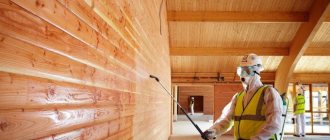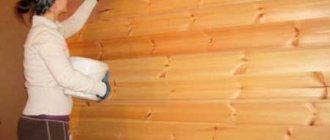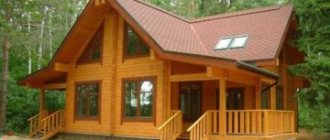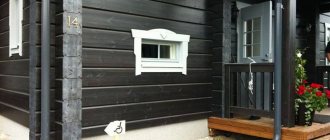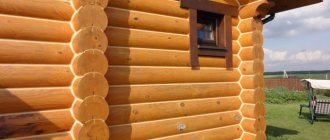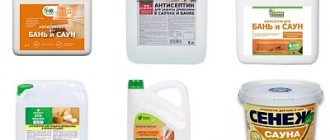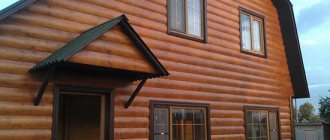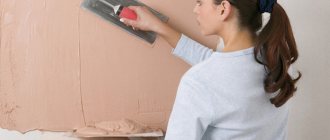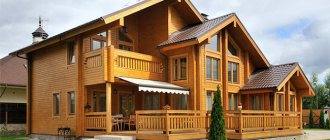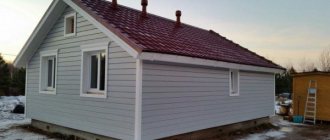In the photo: finishing the steam room of a bathhouse with wood (lining)
Anyone who wants their bathhouse to last as long as possible is considering various options for extending its life. Various impregnations are just among the products that promise just that. But let's find out what they are and where they are most appropriate.
For this purpose, we decided to divide our article into two parts, devoting one of them to impregnations for the bathhouse inside, and the other to the outside.
The difference is obvious - everything that is outdoors is exposed to solar ultraviolet radiation and seasonal precipitation, frost and heat. This suggests some aggressive response. And what is inside the bathhouse should be as harmless as possible to humans, but still quite effective, because the bathhouse has high humidity.
Folk remedies
If you don’t have a professional tool for processing logs at hand, you can use proven folk methods.
One of the most famous folk remedies is copper sulfate (copper sulfate). Vitriol is affordable and effective. However, copper sulfate is not recommended for indoor use due to its toxicity. Treatment of a log bathhouse with copper sulfate is carried out using the following tool:
- brushes;
- brushes with stiff bristles;
- rubber gloves, thick clothing, a respirator or gas mask.
Vitriol is applied as follows:
- The cleaned surface is thoroughly dried.
- Vitriol is applied to a wooden surface and rubbed well into it.
- After drying the material, you need to apply another 1 to 4 layers of copper sulfate.
Every few years the wood needs to be re-impregnated. Protected wood is not afraid of high humidity, rot, mold and insect pests. You just need to take the work responsibly, spare no time, effort and expense. Then the bathhouse will serve for many decades.
Principles of coloring
In order for the decorative coating to last longer, you need to take into account the specifics of the work and know how to prepare the surface.
Preparation
Before you start applying paint to the walls, floor, ceiling in the bathhouse or outside, you need to complete the following preparations:
- Caulk the timber walls, cover the cracks with a special wood putty. The walls must consist of several layers - vapor barrier, wooden frame, insulation, foil film, slatted frame, finishing material. Paint is applied on top.
- You need to remove uneven surfaces from brick surfaces and knock down old mortar. Depressions and cracks should be covered with plaster.
After leveling the surfaces, you can begin decorative finishing.
Wood putty (Photo: Instagram / color_174)
Tools
To perform the work you need to prepare:
- Tassels. Can be with natural or artificial bristles.
- Rollers. There are fur, velor, polyamide, foam rubber.
- Sharp knife, scissors.
- Dry rags, solvent.
- Containers for paint.
- Thick polyethylene film.
- Plastic stick.
- Masking tape.
If you need to paint the outside of the building, it is recommended to use a spray gun. With its help you can quickly paint large surfaces.
Features of the work
You need to start painting the walls, ceiling, floor by cleaning the room and preparing consumables. All items that cannot be painted must be covered with plastic wrap. Skirting boards and trim can be sealed with masking tape. The composition is applied in one layer. If it is not enough, you can apply a second one. Metal surfaces must be pre-primed.
Masking tape (Photo: Instagram / detailingmarket)
What is better for processing
Wooden baths: insulation of a bathhouse made of timber from the inside or outside, insulation with a steam room, mineral wool or something else, and is it necessary at all?
After identifying the cause of the problem, you need to find ways to solve it
It is important to choose the right product to protect the ends of the timber so that they do not crack
Sealant treatment
The use of sealant does not require additional treatment of the wood with various antiseptics.
Thanks to the sealant, you can forget about cracks for a long time. It has the following effect:
Another processing method is to coat the logs with paint.
Using paint as an end putty:
Lime
This natural antiseptic is distinguished by the fact that:
However, this composition does not provide long-lasting protection and is quickly washed off by rain. The treatment will have to be repeated several times a year.
Experts advise using lime only for the first two years, and then using more reliable professional products.
Biotor
Thanks to this solution, the deformation of the log is noticeably reduced.
The BIOTOR composition forms an elastic coating that is absorbed into the wood several centimeters, thanks to this:
Biotor retains its protective properties for a long time. This is a frost-resistant and fireproof material without solvents or odor.
After applying the antiseptic, the shade of the wood changes slightly, which allows you to control the untreated areas.
The coating has the following effects:
The resulting colorless film preserves the natural grain of the wood.
Senezh Tor
The product penetrates deeply into the wood and forms a reflective thick-layer elastic coating on the end surface, which normalizes the evaporation of excess moisture. In addition, this antiseptic:
The protective composition does not contain prohibited chemical compounds and is therefore safe for health.
Experts are against processing end cuts with the following folk remedies:
They clog the pores of wood, disrupt air circulation and moisture exchange at the site of application.
How to get rid of wood blue stains
An alarming “bell” is a change in the color of the wood and the appearance of bluish or blue-gray bald spots on the surface of the external walls; a log house under shrinkage is most often susceptible to this phenomenon. The appearance of blue discoloration is caused by the development of a fungus that feeds on wood starch and glucose. Blue appears actively in the first months after the construction of a log house; the cause of this phenomenon is most often the use of waterlogged timber.
It is believed that blue fungus does not destroy wood fibers, the tree retains its properties, but its appearance indicates that something is wrong with the wood material and measures must be taken. In recent studies, scientists have noted that blue damage does not go away without a trace; in the affected areas, an increase in pores is observed and hygroscopicity increases. This phenomenon reduces the service life of the structure.
The blue develops from the outside and penetrates deeply into the timber; sanding does not completely eliminate this defect; the façade of a house with blue-gray stains has an unpresentable appearance. Blue mold is easily eliminated with chlorine bleaches “Belizna”, “Iney”, “Sagus”. It is advisable to carry out the treatment immediately after the first signs of damage appear; if the timber is covered with blue in the stack, it is advisable to treat it before laying it in the log house and further dry it in a well-ventilated place.
Wood blue: 1-surface; 2-deep.
Types of protective coatings for wooden baths
Products for internal treatment of wooden baths
Warm seam for a wooden (their log) house in 6 steps. choosing the right sealant
Let's consider how to treat the inside of a wooden bathhouse:
- The walls of the log house in the steam room and washing room are treated with special substances on a natural basis without artificial additives, which do not emit toxic fumes at high temperatures and humidity. Such preparations belong to the highest degree of environmental safety.
- For interior work, use Teknowax 1160 - a special wax for baths. The substance is odorless, without toxic elements. After application, it forms a smooth film on the wall that does not allow liquid and steam to pass through and can withstand high temperatures. They produce two types of bath wax - transparent and whitish. Transparent retains the wood texture. White wax visually expands the room. The product can be used to cover walls in the steam room, washing room and other areas of the bathhouse.
- To treat logs in the dressing room and rest room, you can use harmless products that do not cause allergic reactions. Such preparations include Teknocoat Aqua 2550. This is a water-borne acrylic varnish that forms a protective film on the wall. The film is elastic and washes well.
Products for external treatment of wooden baths
Let's find out how to treat the outside of a wooden bathhouse:
- Impregnations can protect wood from ultraviolet radiation, but cannot withstand precipitation. Water washes away protective substances from wood, the sun burns bald spots on it, as a result, the appearance deteriorates, and the logs quickly deteriorate. Impregnations protect wood for 5 years. Therefore, it is necessary to re-coat the walls with protective substances.
- When walls are varnished, an indelible film remains on the wood, protecting the building from moisture and ultraviolet radiation. Before treating a wooden bathhouse with varnish, inquire about the properties of the protective film it creates. If it is too rigid, it can tear and crumble when the structure shrinks or the natural expansion of the wood. For outdoor work, purchase varnishes that create an elastic film. Therefore, it is not recommended to cover the outside of the bathhouse with yacht varnish.
- For exterior use, it is recommended to use Aquatop 2920-04 varnish, which creates an elastic coating. The protection will last 15 years.
- Also, high-quality protective materials for wooden external walls are produced by well-known foreign companies Tikkurila, Pinotex, Remmers.
- Among domestic products, we can offer products from manufacturers Senezh, Aquatex, Rogneda.
- You can also use ancient means to protect log houses. The most famous are drying oil from vegetable oils, tar and tar from charcoal. True, the appearance of the building will deteriorate slightly.
- Instead of varnish, the walls of the bathhouse can be painted on the outside. Paint is chosen according to a similar principle - to retain water and ultraviolet radiation. Therefore, the darker the color, the better the protection. Apply paint in several layers.
Types of antiseptics for wooden baths
- Washable antiseptic
. It is made on the basis of metal salts. Salts are washed out with water, so they are used to treat the interior of the bathhouse - the dressing room and the living room. Washable ones are not used to cover the outside of the bathhouse, the walls of the steam room and the washing room. - Hard-to-wash antiseptic
. Designed for processing the log house from the outside. The substance contains oil and synthetics. - Short-term antiseptic
. Used to cover individual surfaces of logs during construction.
When choosing antiseptics, remember that high-quality antiseptics are expensive
Pay attention to the label: it should say that the substance protects against all biological threats - mold, mildew, rot, etc.
Why are external walls treated with bleach?
Bleaching compounds contain chlorine or hydrogen peroxide, which have a detrimental effect on microflora; these products are used to treat the outside of buildings. The operation has a dual purpose:
- Affects spores of all types of fungus,
- Cleans the surface of the timber and the pores of the wood from contaminants.
Before and after applying bleach
Bleaching of the outside of a log house is carried out for preventive purposes and to update the facade; during the period of operation of the building, this operation is repeated periodically. Experts recommend treating walls in this way every time before applying protective impregnations. The most popular products include: “CEDAR (Bleach)”, “Nortex-Bleach” and “Bioshield-2”; a sprayer can be used to apply these solutions.
Material selection
All stages of construction of a 3 by 4 meter bathhouse
To insulate baths, a wide range of materials of both natural and artificial origin is used. It is noteworthy that to this day, when constructing bathhouses and outbuildings, many owners of personal plots use materials that were used for insulation several centuries ago.
When choosing a material for caulking a log house, you should pay attention first of all to the types of insulation that have such properties as:
- environmental friendliness;
- chemical and radiation inertness;
- resistance to moisture;
- resistance to high temperatures;
- resistance to sudden temperature changes;
- resistance to mold and rot;
- biostability (resistance to damage by insect pests);
- durability (service life).
The inter-crown insulation must provide reliable protection of the building from blowing. The insulation will meet this requirement only if it has sufficient density and elasticity (compliance).
Painting the outside of a log house: factors affecting quality
The quality of painting a wooden country house depends mainly on two factors:
- Weather. Ideal weather is dry and windless. Do not paint in the sun (the paint will dry too quickly and unevenly), during or after rain. The permissible temperature is determined by the type of paint (indicated on the label).
- Wood moisture content. It should not exceed 20% during painting, so façade walls made of wood with natural humidity are painted after the frame has shrunk.
A necessary condition for a quality result is ease of use. Source projecty-domov.ru
Following several rules will help make the painting of a log house durable:
- Ends of logs. They are treated with lime or water-based paint for the first time immediately after cutting the log house (this prevents the logs from drying out suddenly and reduces cracking). After sanding, the ends are painted at least 3-4 more times.
- Tool. A spray gun helps to apply paint quickly and evenly if you have experience. Otherwise, a wide brush with a dense padding will be the best choice. The paint is applied with a brush in the longitudinal direction (according to the location of the crowns of the log house).
- Working methods. If necessary, intermediate manual sanding with re-application of primer is allowed. The glazing or covering antiseptic should be stirred periodically during operation; this will help the pigment to distribute evenly.
Painting of the wooden house is completedSource yandex.ru
Bath paint: types and choice
Types of bath paints
- Professional
. Difficult to use because they require knowledge of the technological map. They contain different emulsions, which are applied in 3-4 layers. They are distinguished by their high cost. - Construction and household
. They are more common due to their ease of use and relative cheapness. They consist of one material, which is used to paint the surface in 1-3 layers.
- Water-based dispersion acrylic
. They protect the tree from low temperatures and unfavorable climatic conditions. They are durable and do not lose performance characteristics for up to 10 years. Quick-drying and most suitable for processing baths, since they do not interfere with the natural air exchange of wood. It is not advisable to apply them to surfaces treated with salt fire retardants. Price - from 650 rubles per 1 liter. - Oily
. Not recommended for external use due to high sensitivity to UV radiation. Cost - from 400 rubles per liter. - Enameled
. Used for brick structures, applied to a previously plastered surface. They are inexpensive - from 70 rubles per liter. - Alkyd resins
. They fade faster, fade and lose their appearance. They are relatively inexpensive - from 300 rubles per liter. - Silicate
. They are made on the basis of liquid glass and are suitable only for painting brick steam rooms. From 150 rubles per liter. - Water-based bath paint
. It is resistant to moisture, and therefore can be used for painting the ceiling in a washing room for brick buildings. Price - from 40 rubles per liter.
Bathhouse exterior painting technology
During the process we adhere to the following algorithm of actions:
Carefully sand the wooden surface. If the log house is not new, then remove the top darkened layer and treat it with a bleaching agent. We remove dust from the wall. You can use an air compressor or vacuum cleaner for this purpose. After blowing, wipe the wood with a semi-dry cloth. We impregnate the surface with an antiseptic primer and sand it after hardening. We treat the wood with a fire retardant. Some bioprotective substances already contain a fire-fighting substance. Apply the first thin and even layer of paint (if you are using a spray gun, hold it at a right angle to the wall being painted) and wait for it to dry completely. This usually takes 12-24 hours depending on weather conditions. Sand the surface with 120/140 grain paper. We paint the wall again using the same technology as the first time. Apply a thick layer of paint to the ends of the logs 4-5 times
They have a rough surface, and therefore absorb significantly more coloring matter. Please note that the lower three logs must be processed with special care, since they are more exposed to negative atmospheric influences than others.
Requirements for paints for exterior painting of timber
When choosing a material for painting a bath, it is recommended to determine its characteristics and follow certain rules.
Vapor permeability
This is the main indicator when choosing a material. If the shell is too dense, steam accumulates on the wall underneath it, which leads to rotting of the wood. After several years of operation, gradual peeling of the composition is observed.
The basis
When choosing a material, pay attention to the solvent. For cladding baths, preference is given to organic compounds or paints that are water-based
An organic solvent creates a dense film base that is not capable of fully transmitting steam. When purchasing organic compounds, you need to use paints based on plyolethyl resins.
Water-dispersed paints are developed on the basis of film formers. This is an environmentally friendly composition based on aqueous dispersion or minerals. The first type is:
- Water-dispersed;
- Emulsion;
- Latex;
- Water-based.
For the production of mineral paints, inorganic binders in the form of liquid glass, cement, and lime are used. Enamel paints form a practically non-breathable film, so they are not used for painting baths. When used, the texture of the wood is completely painted over, which leads to its destruction. Timber is not painted with modern synthetic materials, since they contain carcinogens that negatively affect the environment.
Waterproof
On the painted side, the paint should have low absorption capacity, which will protect the facade from getting wet and dirty
When purchasing a composition, you need to pay attention to its absorption level. If the timber is damp, then a temporary antiseptic is used to cover it, which does not form a dense moisture-proof film
Its tinting is carried out to protect it from ultraviolet radiation.
Protection of decorative qualities
The material used to construct bathhouse walls can accumulate dust particles, so care must be taken to ensure that they are washed off by rain. In high-load areas, compounds are used that have a high level of abrasion - over 5000. The floor of the veranda is covered with terrace paint.
UV resistance
When exposed to ultraviolet radiation on the walls of the bathhouse, the possibility of fungus spreading is eliminated. But the sun burns the paint and helps lighten it. Therefore, you need to buy a composition that is resistant to ultraviolet rays. The bathhouse is painted with polysilicon, acrylic or silicone composition. To avoid darkening of the surface, do not use paint based on linseed oil.
Valuable tips for painting a log bathhouse
Let's summarize: the main goal of modern paints for timber is to protect wood from blue stains, mold, UV rays and any other atmospheric phenomena. But in order for the protective coating of the timber to do its job 100%, you must do everything correctly.
Tip #1. Paint the sauna frame yourself
If you paint a log house yourself, you will gain a lot of advantages. After all, it is quite difficult to judge the quality of the team’s work only by the appearance of the bathhouse, and their main task is to create a finished beautiful object. And, unfortunately, workers often leave unnoticeable small gaps in the processing of the log house from the outside. Over time, these places become a source of problems such as rot, mold and destruction of the walls of the bathhouse from the inside.
Tip #2. Properly prepare the log house for painting
First of all, it is important to properly prepare the surface of the log house for painting. To do this, you need to remove all dust and foreign debris.
It is advisable to rinse the bathhouse walls thoroughly with water using a hose and a stiff brush. Then dry well. If necessary, sometimes it makes sense to carry out serious grinding:
If you notice any lesions at this stage, treat them with Woodmaster Frost Whitening Solution. And for cracks and small defects Eurotex is more suitable.
Advice: if you notice traces of mold on the logs of a new bathhouse, it is advisable to consult a mycologist before painting: it is still “harmless” mold or a real destroyer.
In addition to standard cleaning and sanding of the log house, you need to take care of its protection. If you are not sure of the quality of the delivered timber, do not make do with a standard antiseptic - it is better to use Language, which kills all spores. And as a topcoat, choose a Fungicide, which will help prevent the appearance of algae and mold on the surface. In extreme cases, you need to clean the walls well and apply a clear coat of Log washadvance.
Tip #3. Paint the ends with lime or a modern equivalent
This is done in order to force water vapor to move along the log and escape through the ends. This is a natural process that occurs due to the difference in temperature indoors and outdoors, and here the steam room is at particular risk.
If in this case the park runs along the fibers, and not across, this is how moisture moves in a growing tree, well, what should you do if you have to.
Tip #4. Don't leave any gaps
During the process of painting a bathhouse, it is important to ensure that there are no unprotected gaps, which can easily cause many problems. Therefore, add a signal color to a colorless antiseptic, and then leave it to dry for 3 days during a period without rain, so that the active substances are fixed in the wood and the effect is achieved
Tip #5. Choose the most beautiful paint!
Modern manufacturers offer not only compositions that simply paint over the substrate and hide the natural grain of the wood. Today, decorative protective and decorative texture paints for log baths are in fashion, which not only preserve the wood from atmospheric agents, but emphasize its beautiful texture!
And it has additional valuable features. For example, today the following texture paints for Russian log baths are especially in fashion:
- “Favorite Dacha” is an economy-class paint to protect the log house from blue stains, ultraviolet rays, and fungus - and all this without a primer.
- “Aquatex” is a paint with an antiseptic and a modern ultraviolet filter. On the surface of the walls of a log bathhouse, it creates a semi-matte elastic coating, and also without priming. Moreover, it can be applied even to damp wood.
- The “Aquatex Extra” variety is a protective coating, an elastic coating made of natural oil and microfiber. This paint has ultraviolet protection in two ranges.
- In order to paint an old bathhouse, Aquatex Restorer paint is more suitable for you: you will be very surprised by the result.
The appearance of the bathhouse should please the eye and warm the soul!
Based on the article https://cdelayremont.ru/banya-svoimi-rukami
Years of experience or modern technology?
In the new millennium, humanity has become especially concerned about the environmental friendliness of its life, remembering the wisdom of centuries and the traditions of its people. So, the bathhouse has become such an outlet for the Russian people: now almost every second summer resident is trying to build at least a small, but his own steam room. What can I say: the richest landscape designs decorate Russian-style log baths. But just as the filling of such a steam room has changed over time, so have some of the nuances of its construction.
What if you leave it without painting?
Today, many bathhouse attendants leave the walls of bathhouse logs open from the inside and outside, asking the already rhetorical question: why build a bathhouse from an environmentally friendly material, “living and breathing” wood, and then cover it with “chemical film”, aluminum foil and “poisonous” impregnations" from the street side? Therefore, the most ardent adherents of the “true steam room” do not use either vapor barrier or paint, as was done in Rus' throughout the centuries.
When the baths were heated, the log house, like a sponge, absorbed moisture and gave it away just as easily. Of course, such baths lasted no more than 5-10 years, because... became too dry and not fireproof. And already on the site of their ashes, a strong new steam room was built, which was quite a common thing.
You will be surprised, but this practice still exists! True, there is one “but”: you will have to heat a truly Russian bathhouse with the same Russian stove in black style. Because only the smoke from it, which quickly smoked the new bathhouse from the inside, is capable of disinfecting its walls from the ubiquitous fungus.
Why isn't any paint or varnish suitable?
Let's give a good example. The modern market is simply replete with materials for finishing timber outside: both in the method of action and in color and texture. But even relatively recently, in Soviet times, most wooden buildings were covered with ordinary oil paint. Cheap and cheerful, as they say, and a rich palette of shades.
Therefore, many novice bath attendants today think: why spend money on more expensive paint if you can use the same oil paint? The trouble is that the wood under such paint does not breathe, and the water vapor from the steam room remains in the walls. As a result, wood insects, mold and rot easily grow in such a log house. As a result, a completely new bathhouse has a grayish coating on top of its spectacular shade, not to mention the internal destruction of the walls themselves.
After all, even those modern baths, which are covered from the inside with a whole cake of moisture and vapor barriers, cannot be 100% protected from water vapor. Look at the numbers indicated by manufacturers of conventional vapor barrier films, which retain water vapor by only 75-80%. And even expensive membranes do their job only 95-97%. Therefore, it is extremely important that the paint or impregnation for timber is universal and performs all its important functions.
See why not all substances are suitable for treating wooden bath walls:
Processing a wooden house from the outside: selection of products and step-by-step instructions
A wooden house is an environmentally friendly and safe housing that will never lose popularity. Natural wood does not emit toxic hazardous substances, has a pleasant forest aroma and promotes rapid oxygen exchange. In such a house there is always fresh air, a comfortable environment and a cozy atmosphere.
The logs are easy to lay, which reduces installation time. Due to their light weight, they do not require a deep, expensive foundation. And thanks to the natural beauty and aesthetics of the materials, serious and expensive finishing is not required.
However, wooden houses also have a significant disadvantage. Wood is a natural material that is subject to negative environmental influences. Sun rays, moisture and precipitation, insects lead to the fact that the material gradually darkens and collapses. Mold, cracks and fungus appear, and the structure loses its original appearance. To avoid these problems, it is necessary to treat the log house inside and outside using various means.
Protective impregnations for baths
The most popular impregnation for protecting the wooden walls of a bathhouse from destructive insects, mold, rot and fungi is an antiseptic. But you need to choose them carefully; there are compounds that, when exposed to high temperatures, release toxic substances into the air. Serious health problems can result from being in such a bathhouse. Therefore, antiseptics must be absolutely safe, preferably water-based.
The Neomid company has these; Neomid 440 Eco is perfect for external treatment of bath walls. It prevents the formation of fungi and mold, and does not change the structure of the wooden material. It can provide protection for a period of 25 years, but provided that the surface is covered with the decorative film-forming composition Neomid Biocolor Aqua, Ultra or Classic. All of them prevent the leaching of the antiseptic, the fading of the wooden material, and have enhanced protection against ultraviolet rays, biological pests and wood insects.
To treat the inside of the bathhouse, good antiseptics Neomid 200 and Senezh Sauna are available for sale. They can protect the surfaces of walls, ceilings, shelves, benches from destructive fungi and insects, despite the high temperature and humidity.
A good option for a bath would be to choose antiseptics containing fire retardants. These components prevent the wooden material from igniting, and the risk of fire is high, because in the bathhouse there are fire-hazardous stoves, boilers, and electric heaters. For example, these could be the compositions Neomid 450 or Neomid 450-1. And Neomid Antibug 100 will help get rid of insects and prevent their appearance. It is deeply and quickly absorbed into the wood and provides reliable bioprotection for 25 years.
Inside the bathhouse, an excellent option would be to use wax-based protective impregnations. Such a product could be the protective varnish “Eurotex-Sauna”, produced by the domestic manufacturer Rogneda. It is made on the basis of acrylic and wax. It can be used to treat all wooden surfaces in the bathhouse, with the exception of shelves. And they, in turn, can be protected with Eurotext-Sauna oil. Or use special oil for baths and saunas based on natural oils produced by Neomid. It prevents fungi from developing, penetrates deeply into the wood, and is safe for contact with skin. Creates a decorative coating that does not crack or delaminate, despite harsh conditions.
Brief conclusions
I will answer a possible question - is it possible to paint a stove in a bath with oil, alkyd, vinyl, latex, acrylic, dispersion and other paints. I answer - it is possible. Just bake, don’t heat it later...
Tikkurila - heat-resistant paint
There is another option - experiment. For example, a friend decided to use paint for car mufflers, someone is trying something based on liquid glass, and so on. There are many different forums. If you do not want to paint an iron stove, you can do bluing. We associate this word with firearms. A good low budget option. How long will it last? Don't know. But good heat-resistant enamel is promised by manufacturers to last for at least 15 years.
I hope the article was useful to you. If yes, then subscribe to the blog and recommend it to your good friends through social networks.
Anecdote: “My husband comes in the morning covered in lipstick, powder, and red hair.
Wife: - Where have you been?
“You won’t believe it, my dear, I fought with a clown all night.”
Wisdom Quote: Pleasure should be the reward for work.
Peculiarities
Caulking a bathhouse is a procedure carried out to minimize heat loss during the further operation of the structure. During the caulking process, the cracks, joints and gaps between the logs of the log house are filled with heat-insulating material (inter-crown insulation). As a result:
- the volume of heat loss during operation of the bath is reduced;
- the time for kindling and warming up the premises is reduced;
- fuel and electricity costs are reduced.
Caulking is a procedure that is carried out repeatedly throughout the construction of the bathhouse. This is due to the fact that the process of building a structure is accompanied by natural drying of the logs and gradual shrinkage of the log house, as a result of which new cracks may form in different parts of the bathhouse.
This procedure is carried out in two ways - stretching and dialing. In the first case, the insulation is placed in the cracks with fibers across, leaving an edge of the material 4-5 centimeters wide outside. Then this edge is rolled up with a roller, which is tucked into the cracks with a chisel.
In the second case, the insulation fibers are twisted into tight strands, which are pushed into the cracks between the logs using a chisel.
Processing of a sauna log
The standard method of impregnation with an antiseptic involves working with a brush or spray. Working with a brush is more difficult and takes longer. However, it is indispensable in some cases, for example, when a certain area cannot be properly coated with a sprayer. Every 2-3 hours it is recommended to change the brush to a new one.
Impregnation with a spray gun is considered to be of higher quality and, which is absolutely certain, is carried out much faster.
In some cases, alternative methods of processing wooden structures are appropriate:
- Method of immersing wood in a container with an antiseptic agent. This approach guarantees impregnation of even the most difficult to reach areas of the structure.
- The diffuse (dry) method of treating with an antiseptic drug involves applying a paste or powder substance to the surface.
Before you begin to impregnate the log house, it must be cleared of all kinds of blockages. A vacuum cleaner is suitable for this purpose. Then the surface must be thoroughly dried.
The compositions are applied in the following sequence:
- means for protection against fungus and moisture;
- impregnation against insect pests;
- fire-fighting agent (fire retardant).
After finishing surface treatment with antiseptics, it is recommended to apply a gel or primer. However, we must not forget about the basic rule: the material must be breathable.
If everything is done in accordance with the technology, then subsequent impregnations are done no earlier than three years later. Some compositions last up to five years.
Processing the log from the inside
With prolonged and regular exposure to steam and moisture, which the operation of baths implies, the functionality and appearance of wood may suffer. Without the use of special protective equipment, the service life of the log house is reduced. Wood is best protected from harmful effects by special oils for baths and saunas. These are products based on natural ingredients - vegetable fats, wax, lecithin, safe driers, without toxic compounds.
Oils are absorbed into the wood structure, strengthening it and protecting it from steam and water. As a result, the surface does not allow moisture to pass through, repels grease and dirt, and becomes resistant to destruction by detergents. Oils have antiseptic and fungicidal properties, so mold and mildew will not settle on the material. Some brands, for example "Martyanov", additionally include additives against blueing of wood.
The advantages of oil mixtures are obvious:
- Suitable for any type of wood;
- protection even from extreme temperatures;
- improvement of appearance, emphasizing wood grain;
- penetration into hard-to-reach places.
Wood oil for baths and saunas “Martyanov” It is recommended to treat the inside of the log houses of baths and saunas with oils every 5 years, which will preserve the properties of the wood for many years.
Furnace painting
Before staining, the selected composition must be prepared in accordance with the manufacturers' recommendations, which are indicated on the packaging. Some paints must be diluted with solvents, others can be applied at certain temperatures - individually for each substance.
Heat-resistant varnish for oven coating
To paint the stove, the following instructions apply:
- Applying a thin layer of paint to the surface of the oven;
- Repeat the first step 2-3 times and dry the layer after each application;
- Heating the oven and cooling to room temperature;
- Applying the final finishing coat of paint.
A symbolic ornament will add a special charm and beauty to the Russian stove.
There is no need to apply fastening compounds, such as primers after plaster or clay, since almost all fastening compounds cannot withstand high temperatures.
To apply paint, you can use any tool - brushes, rollers, spray guns. Compositions with high thermal performance are also available in bottles with a spray nozzle, but the consumption with this method of application is enormous. You need to buy bottles with a reserve, taking into account the need for several layers of paint.
Painting a metal stove
A metal stove is often installed in a bathhouse; it can also be found in old private houses with a classic design, where the stove was used for cooking, and the metal stove was used to heat the room.
Painted sauna boiler
Painting a metal stove can be done in two ways:
- Cold painting - the coloring composition is applied to cold metal. The metal must first be cleaned of dirt and rust - it is better to use a grinding machine with an attachment for cleaning metal products.
- Burnishing - paint is applied to metal heated to a temperature of 100-150 degrees. This method is the best - the paint “tightly adheres” to the iron.
It is much easier to paint metal using a cold method - the modern market offers an abundance of thermal paints, for example, fire-retardant paints for metal Polistil - they protect the metal even from open fire.
Coloring elements
Metal stove elements
Metal elements - doors, dampers, adjacent elements - are painted with protective substances.
Furnace parts must be coated with paints that can withstand high temperatures. Parts that are only adjacent to the stove can be coated with a refractory compound or galvanized - for this, Zinga electrically conductive paint is used, which protects the metal from corrosion and other external influences.
The chimney heats up to a greater extent at the junction with the flame part, gradually cooling down in the upward direction. Also, the chimney is exposed to the influence of natural phenomena in the area where it faces the street.
Before painting the chimney, it must be thoroughly cleaned with a grinding machine. Then it can be coated with compounds - silicon-organic or water-based paint.
Painting a bathhouse: step-by-step instructions
- Preparing for painting
- Exterior painting
- Dye
- Varnish
The walls of the bathhouse need protection from temperature changes, exposure to precipitation and ultraviolet radiation
In order to provide the walls with maximum resistance to negative factors, impart aesthetic appeal and extend the service life of the bathhouse, it is important to choose the right coloring composition and correctly paint the surface.
Products for exterior painting of baths
Selection of paints for painting a bath
- Oil paint
. Very sensitive to sunlight. It is used quite rarely for painting wooden baths. Price - from 400 rubles per liter. - Alkyd paint
. It comes in oil-based and varnish. To paint a log house, it is better to use enamel paint based on varnish. Price - from 300 rubles per liter. - Emulsion paints
. This class includes water-based, water-dispersed, and acrylic compositions. The last two options are the optimal solution for exterior painting of a log bathhouse. They allow the wood to “breathe”, do not contain harmful chemical solvents and are well diluted and removed with water until they polymerize on the surface. They are not afraid of the sun's rays; these paints are quite durable. The cost of 1 liter is from 650 rubles.
Choosing a varnish to cover a bath
- Alkyd
. Used for external and internal work. Very durable and moisture resistant. The downside is that it takes a long time to dry. Price - from 700 rubles per liter. - Acrylic
. It is believed that varnishes of this type are the most environmentally friendly. They are fireproof, durable and elastic. Retains the original appearance of wood for many years. Price - from 200 rubles per liter. - Epoxy
. This category of varnishes is waterproof and resistant to mechanical and chemical factors. They dry quickly and are widely used for exterior finishing work. From 350 rubles per 1 liter. - Polyurethane
. These varnishes are rightfully considered one of the most popular. Very resistant to abrasion, mechanical damage, and chemical attack. A wide range of these varnishes allows you to choose the one suitable for exterior wood finishing work. Cost - from 1200 rubles per liter.
Exterior painting technology for a wooden bath
Rules for painting bath walls with paint
- We cover areas that do not require painting.
- Next, you should make sure that the caulking material is tightly packed into the cracks.
- Apply the first layer of paint with a brush, roller or spray. We paint the walls, holding the sprayer at a right angle and moving it evenly. Let the paint layer dry.
- Carefully sand the painted surface to remove any lint that appears.
- If painting is done with a sprayer, then at the bottom we change the angle of inclination to completely cover the entire surface with paint.
- Apply another layer of paint.
Features of painting a bathhouse with varnish
When choosing a tool, keep in mind that after painting with a brush or roller, the surface acquires a matte texture. At the same time, spray painting gives the walls a glossy look. Apply the first layer of varnish. For this it is better to use a spray bottle. After this coating, there will be fewer unevenness than after working with a brush.
Do not forget to cover items that do not require painting with a protective cloth. Sand the surface after complete drying. We open the wall with a second layer, paying special attention to the seams and corners. Try to keep the spray gun at approximately the same distance from the surface during the entire process.
tutknow.ru>
Dyeing process
Features of applying decorative composition
Before painting the inside of the bathhouse, you should select the tools used for this purpose. After all, the quality and appearance of the surface also depends on this.
There are two main options:
- Spray. Thanks to it, you can paint the surface as quickly and efficiently as possible. In addition, this method practically does not raise wood fibers, so the walls will not need to be thoroughly sanded after treatment.
- Brush. Despite the seeming archaism of this device, many experienced craftsmen advise using it, especially when applying the base layer.
Paint brush
Work order
Painting the inside of a bathhouse begins with purchasing the necessary materials and equipment.
For ease of presentation, the process itself is divided into several stages:
- Prepare the area for work. Considering that you will have to paint not only the walls, but also the ceiling, you should make sure that there are stools, stepladders or scaffolding that allow you to gain access to any point in the room.
- Clean the surface. This phase is very important. You should sand the wood very carefully so that when you run your hand over it, you don’t get a splinter in your palm and feel a smooth surface. A vacuum cleaner or damp cloth will help get rid of dust and sawdust. For best results, you can treat the surface with white spirit.
- Apply a base coat of paint or varnish. Wait until it dries and sand the surface again with fine-grained sandpaper.
- Cover the wall with a second layer, for which it is better to use a sprayer. Before doing this, you need to cover the areas that will not be painted with paper and masking tape.
Before painting, you need to thoroughly clean the surface
Basic rules for bath treatment
Useful tips
Preparations for processing timber should be purchased at specialized retail outlets. Various flea markets and street stalls are not an option. It is in such places that cheap fakes are mainly sold, which will not provide reliable protection for the wood of the bathhouse.
When choosing any product, you need to pay attention to the depth of its penetration into the material. The higher this indicator, the better
One of the enemies of wood is ultraviolet radiation. By the way, as practice shows, few people think about this. But the sun's rays destroy this material no worse than biological pests and moisture, although this is expressed somewhat differently. The appearance of cracks, cracks, and twisting of timber is the basis for unscheduled repairs of the bathhouse. And this, taking into account the specifics of the construction of a log house, is quite an expensive undertaking.
For internal treatment of the bath, you should purchase products that do not contain “chemicals”. Otherwise, harmful discharge (and there will definitely be some, at least from high temperature) is inevitable. As an example, a wax composition for treating a timber bathhouse from the inside “Teknowax 1160”, acrylic varnish “Teknocoat Aqua 2550”.
External treatment of the bath can be done with Aquatop 2920-04. This is a varnish that forms a thin transparent film on the timber.
The article provides examples of compositions that are used when processing timber inside and outside the bathhouse. But they are not the only ones. It is easy to find a good alternative to these drugs in a specialty store if they are out of stock.
Price of paintwork
The cost of painting a timber house consists of the cost of materials and a set of works to cover the facade
.
By comparing the price of paints from different manufacturers, the need for the material is determined. The square footage of the facade is multiplied by the consumption of the composition
indicated on the packaging label, taking into account the number of layers applied.
Add 10% for margin and errors in calculations
to the resulting figure. Paint consumption can vary between 100-250 grams per square meter. It is the total amount, and not the unit cost, that will give an idea of the costs.
One of the most popular materials for finishing indoors and outdoors is wooden beams. This material has many positive qualities, such as environmental friendliness, affordable price, practicality and presentable appearance.
To increase the service life of lumber, it needs the most reliable protection, since otherwise the material will begin to blacken and crack. The best option to protect a wooden surface is to paint the timber both outside and inside the house. Paint will be an effective and simple protection for rounded or log beams.
